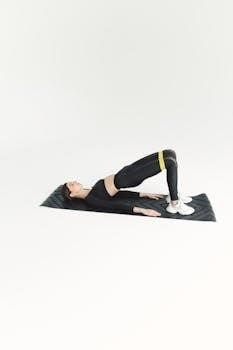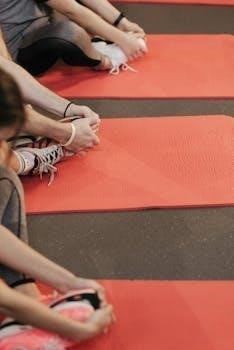Calisthenics Exercises PDF⁚ A Comprehensive Guide
Calisthenics is a fantastic way to build strength and fitness using your bodyweight․ This guide offers a comprehensive list of exercises in PDF format‚ perfect for creating a personalized routine․ It covers various movements targeting different muscle groups‚ suitable for all fitness levels․
What is Calisthenics?
Calisthenics is a form of exercise that uses your body weight for resistance․ It’s a versatile and accessible method‚ requiring no gym or equipment‚ making it ideal for people of all fitness levels․ It utilizes gravity and body weight to challenge and improve one’s physical state․ The term calisthenics comes from the Greek words kalos‚ meaning beauty‚ and sthenos‚ meaning strength․
This comprehensive guide provides a complete list of calisthenics exercises‚ featuring up to 70 movements that work throughout the entire body․ Each exercise is categorized based on difficulty and the specific muscle group it targets․ This allows you to easily integrate them into your calisthenics workout program‚ depending on your fitness level․
Whether you’re a beginner or an advanced athlete‚ you can use this guide to create a personalized routine that meets your needs․ The exercises range from simple movements like push-ups and squats to more challenging exercises like pull-ups and dips․ By mastering the basics and gradually progressing to more advanced movements‚ you can achieve your fitness goals with calisthenics․ So‚ dive in and explore the world of bodyweight training!
Benefits of Calisthenics Training
Calisthenics training offers a multitude of benefits for individuals of all fitness levels․ One of the primary advantages is its accessibility․ Because it relies solely on bodyweight‚ you can perform calisthenics exercises virtually anywhere‚ eliminating the need for expensive gym memberships or specialized equipment․ This makes it a convenient and cost-effective way to stay in shape․
Beyond convenience‚ calisthenics promotes functional strength․ These exercises engage multiple muscle groups simultaneously‚ mimicking real-life movements and enhancing overall coordination and balance․ This type of training builds a strong‚ resilient body capable of handling everyday tasks with ease․ It also improves your body awareness and control‚ leading to better posture and reduced risk of injury․
Furthermore‚ calisthenics is highly adaptable․ You can easily modify exercises to suit your current fitness level and gradually increase the difficulty as you progress․ This ensures continuous challenge and prevents plateaus․ The variety of exercises available also keeps workouts engaging and prevents boredom․ From building muscle and improving endurance to increasing flexibility and boosting cardiovascular health‚ calisthenics offers a holistic approach to fitness․
Calisthenics Workout Plan PDF for Beginners
Starting your calisthenics journey can be exciting‚ and a structured workout plan is essential for success․ A Calisthenics Workout Plan PDF designed for beginners provides a clear roadmap‚ guiding you through the fundamental exercises and helping you build a solid foundation․ This plan typically includes a series of bodyweight movements that are easy to learn and modify‚ ensuring a safe and effective introduction to calisthenics․
The PDF will outline the specific exercises‚ sets‚ reps‚ and rest periods for each workout session․ It often incorporates exercises like push-ups‚ squats‚ planks‚ and lunges‚ which target major muscle groups and promote overall strength and stability․ The plan also emphasizes proper form and technique‚ crucial for preventing injuries and maximizing results․
Furthermore‚ a beginner’s PDF plan will gradually increase the intensity and complexity of the exercises as you progress‚ allowing your body to adapt and grow stronger over time․ It may also include modifications for each exercise‚ catering to different fitness levels and addressing any limitations․ By following a well-designed Calisthenics Workout Plan PDF‚ beginners can confidently embark on their fitness journey‚ build a strong foundation‚ and achieve their desired results․
Intermediate Calisthenics Exercises and Routines (PDF)
Once you’ve mastered the basics‚ it’s time to elevate your training with intermediate calisthenics exercises and routines․ An Intermediate Calisthenics Exercises and Routines PDF offers a structured approach to advance your skills and build upon your existing strength․ This level introduces more challenging movements that require greater body control and coordination‚ pushing your limits and helping you achieve new levels of fitness․
The PDF will typically include exercises such as pull-ups‚ dips‚ handstand push-ups progressions‚ and more complex variations of squats and lunges․ These exercises engage multiple muscle groups simultaneously‚ enhancing your overall strength‚ power‚ and athleticism․ The routines will be designed to increase the volume and intensity of your workouts‚ incorporating techniques like supersets‚ drop sets‚ and circuit training to maximize your results․
Moreover‚ an intermediate PDF plan often provides progressions for each exercise‚ allowing you to gradually work towards more difficult variations as you gain strength and skill․ It may also include mobility and flexibility exercises to improve your range of motion and prevent injuries․ By following an Intermediate Calisthenics Exercises and Routines PDF‚ you can confidently progress your calisthenics journey‚ overcome plateaus‚ and unlock your full potential․
Advanced Calisthenics Workout Plan (30-Day Challenge) PDF
For those seeking the pinnacle of bodyweight mastery‚ an Advanced Calisthenics Workout Plan (30-Day Challenge) PDF is the ultimate resource․ This plan is designed for experienced individuals who have already built a solid foundation in calisthenics and are ready to push their limits with incredibly challenging exercises and routines․ The PDF provides a comprehensive 30-day program that will test your strength‚ endurance‚ and mental fortitude․
Expect to encounter exercises such as muscle-ups‚ one-arm pull-ups‚ handstand push-ups‚ and advanced core exercises that demand exceptional body control․ The routines will be structured to maximize muscle growth‚ strength gains‚ and overall athleticism․ The PDF will include detailed instructions‚ progressions‚ and variations to help you safely and effectively perform each exercise․
This 30-day challenge will require dedication‚ discipline‚ and a strong commitment to achieving your fitness goals․ It is not for the faint of heart‚ but if you are ready to take your calisthenics training to the next level‚ the Advanced Calisthenics Workout Plan (30-Day Challenge) PDF is your key to unlocking unprecedented levels of strength and skill․

Calisthenics Exercises for Chest‚ Shoulders‚ and Arms

Calisthenics offers a wealth of exercises for sculpting a powerful chest‚ strong shoulders‚ and defined arms‚ all without the need for weights․ The core of these exercises revolves around variations of push-ups‚ each targeting different areas of the upper body․ Standard push-ups work the entire chest‚ while incline push-ups emphasize the lower chest and decline push-ups target the upper chest․
For shoulders‚ pike push-ups and handstand push-ups (progressing towards wall-assisted versions) are excellent choices․ These exercises challenge the deltoids and trapezius muscles․ Diamond push-ups‚ with hands close together under the chest‚ are superb for engaging the triceps․ Dips‚ performed on parallel bars or using dip bars‚ are another fantastic exercise for chest and triceps development․
To further isolate the biceps‚ consider incorporating bodyweight rows with an underhand grip․ These can be done using a sturdy table or a low bar․ Remember to focus on proper form and controlled movements to maximize muscle activation and prevent injuries․ This section will provide a comprehensive list of these exercises in PDF format for easy reference․
Calisthenics Exercises for Back and Core
Developing a strong back and core is fundamental for overall fitness and stability‚ and calisthenics provides effective exercises for this purpose; For the back‚ pull-ups and chin-ups (variations with different grips) are king․ These exercises engage the latissimus dorsi‚ rhomboids‚ and trapezius muscles․ Bodyweight rows‚ performed under a table or using gymnastic rings‚ are another excellent option for targeting the back muscles․
Core exercises in calisthenics are plentiful․ Planks (standard‚ side‚ and reverse) are isometric exercises that strengthen the entire core․ Crunches‚ leg raises‚ and Russian twists work the abdominal muscles․ Hollow body holds are a challenging exercise that improves core stability and control․
For a more dynamic approach‚ consider exercises like mountain climbers and bicycle crunches․ These movements engage the core while also providing a cardiovascular workout․ Remember to maintain proper form throughout each exercise‚ focusing on controlled movements and engaging the core muscles․ This section will provide a detailed list of back and core exercises in a downloadable PDF‚ allowing you to easily incorporate them into your routine․
Calisthenics Exercises for Legs and Glutes
Calisthenics offers a wide array of exercises to effectively target the legs and glutes‚ utilizing bodyweight for resistance․ Squats‚ the cornerstone of leg workouts‚ can be modified to increase difficulty․ Variations like pistol squats (single-leg squats) and jump squats provide an added challenge for strength and power․ Lunges‚ both forward and reverse‚ are excellent for targeting the quadriceps‚ hamstrings‚ and glutes‚ promoting balance and stability․
Glute bridges and hip thrusts effectively isolate the glute muscles‚ enhancing hip extension and strength․ Calf raises‚ performed on a flat surface or elevated platform‚ target the calf muscles‚ improving ankle stability and lower leg strength․ Step-ups‚ using a bench or elevated surface‚ engage the quads‚ hamstrings‚ and glutes while also improving balance and coordination․
For a more dynamic approach‚ consider exercises like plyometric lunges and squat jumps․ These movements enhance explosiveness and power in the lower body․ Remember to maintain proper form throughout each exercise‚ focusing on controlled movements and engaging the target muscles․ This section will provide a detailed list of leg and glute exercises in a downloadable PDF‚ allowing you to easily incorporate them into your routine for a well-rounded lower body workout․
Importance of Warm-up and Cool-down Routines in Calisthenics (PDF Examples)
Warm-up and cool-down routines are crucial components of any calisthenics program‚ significantly impacting performance‚ injury prevention‚ and recovery․ A proper warm-up prepares the body for exercise by gradually increasing heart rate‚ blood flow‚ and muscle temperature․ This enhances flexibility and reduces the risk of muscle strains and tears․ Dynamic stretching‚ such as arm circles‚ leg swings‚ and torso twists‚ is ideal for warming up as it mimics the movements performed during the workout․
Cool-down routines are equally important‚ allowing the body to gradually return to its resting state․ This helps prevent muscle soreness and stiffness by promoting blood flow and removing metabolic waste products․ Static stretching‚ holding each stretch for 20-30 seconds‚ is effective for improving flexibility and reducing muscle tension during the cool-down․

This section provides downloadable PDF examples of warm-up and cool-down routines specifically tailored for calisthenics․ These routines include a variety of dynamic and static stretches targeting major muscle groups‚ ensuring a comprehensive approach to preparing the body for exercise and promoting recovery afterward․ By incorporating these routines into your calisthenics program‚ you can optimize your results and minimize the risk of injury․
Nutrition Guidelines for Calisthenics Training
Proper nutrition is essential for maximizing the benefits of calisthenics training․ A well-balanced diet provides the energy and nutrients needed to fuel workouts‚ support muscle growth and repair‚ and optimize overall performance․ Calisthenics relies heavily on bodyweight exercises‚ making it crucial to maintain a healthy body composition through diet․
Prioritize whole‚ unprocessed foods‚ including lean proteins‚ complex carbohydrates‚ and healthy fats․ Protein is vital for muscle repair and growth‚ so include sources like chicken‚ fish‚ beans‚ and lentils in your diet․ Complex carbohydrates‚ such as whole grains‚ fruits‚ and vegetables‚ provide sustained energy for workouts․ Healthy fats‚ found in avocados‚ nuts‚ and olive oil‚ support hormone production and overall health․
Hydration is also crucial‚ so drink plenty of water throughout the day‚ especially before‚ during‚ and after workouts․ Consider your individual needs and adjust your calorie intake accordingly․ If your goal is to build muscle‚ you may need to consume more calories than you burn․ If your goal is to lose weight‚ you will need to create a calorie deficit․ Consulting with a registered dietitian or nutritionist can provide personalized guidance to optimize your nutrition for calisthenics training and achieve your fitness goals․
Common Mistakes and How to Modify Calisthenics Exercises
When starting calisthenics‚ it’s common to make mistakes that can hinder progress or lead to injury․ One frequent error is poor form‚ which reduces exercise effectiveness and increases strain on joints․ Focus on controlled movements and proper alignment‚ watching videos or seeking guidance from a trainer․ Avoid rushing through repetitions․
Another mistake is starting with exercises too advanced for your current strength level․ This can lead to frustration and injury․ Modify exercises to match your abilities․ For example‚ if you can’t do a full push-up‚ start with knee push-ups․ Similarly‚ assisted pull-ups can help build the strength needed for unassisted ones․ Listen to your body and gradually increase the difficulty․
Neglecting warm-up and cool-down routines is another common mistake․ Warm-ups prepare muscles for exercise‚ reducing injury risk‚ while cool-downs aid recovery․ Not engaging the core properly is also a problem․ A strong core stabilizes the body and improves exercise efficiency․ Finally‚ holding your breath during exercises is detrimental․ Breathe rhythmically throughout each movement․ Modifying exercises and correcting these mistakes ensures safe and effective calisthenics training․

Recovery Strategies for Calisthenics Training Plans
Effective recovery is crucial for maximizing the benefits of any calisthenics training plan․ It allows your muscles to repair and rebuild‚ preventing overtraining and injuries․ One key strategy is adequate sleep‚ aiming for 7-9 hours per night to support muscle recovery and hormone regulation․
Nutrition plays a vital role; prioritize protein intake to aid muscle repair and consume a balanced diet rich in vitamins and minerals․ Hydration is also essential‚ so drink plenty of water throughout the day․ Active recovery‚ such as light cardio or stretching‚ can improve blood flow and reduce muscle soreness․
Foam rolling or massage can help release muscle tension and improve flexibility․ Consider incorporating rest days into your training schedule to allow your body to fully recover․ Pay attention to signs of overtraining‚ such as fatigue‚ decreased performance‚ and increased soreness‚ and adjust your training plan accordingly․ Stress management techniques‚ like meditation or yoga‚ can also support recovery by reducing cortisol levels․ Implementing these strategies will optimize your calisthenics training and promote long-term progress and well-being․
Sample Calisthenics Workout Schedule (PDF Template)
Creating a structured workout schedule is essential for consistent progress in calisthenics․ A sample schedule can provide a framework to build upon‚ ensuring you target all major muscle groups throughout the week․ The included PDF template will allow you to customize it based on your fitness level and goals․
A typical week might include three to four workout days‚ interspersed with rest days for recovery․ Each workout could focus on different muscle groups‚ such as upper body‚ lower body‚ and core․ For example‚ Monday could be dedicated to upper body exercises like push-ups‚ dips‚ and rows․ Wednesday could focus on lower body with squats‚ lunges‚ and calf raises․ Friday could be a core-focused session with planks‚ leg raises‚ and Russian twists․
Remember to warm up before each workout with dynamic stretches and cool down afterward with static stretches․ The PDF template will include space to record exercises‚ sets‚ reps‚ and notes on your progress․ Consistency is key‚ so aim to stick to the schedule as closely as possible while allowing flexibility for unforeseen circumstances․
